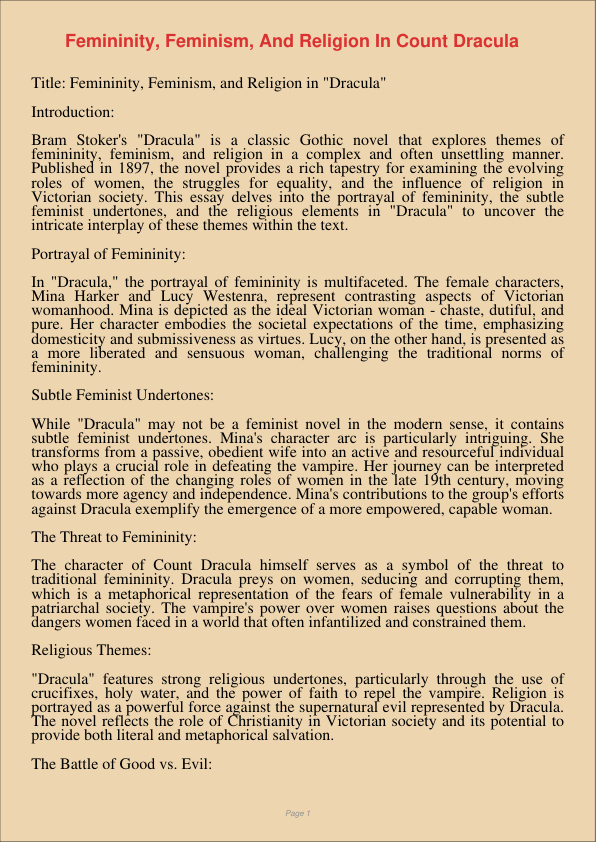
Title: Femininity, Feminism, and Religion in “Dracula”
Introduction:
Bram Stoker’s “Dracula” is a classic Gothic novel that explores themes of femininity, feminism, and religion in a complex and often unsettling manner. Published in 1897, the novel provides a rich tapestry for examining the evolving roles of women, the struggles for equality, and the influence of religion in Victorian society. This essay delves into the portrayal of femininity, the subtle feminist undertones, and the religious elements in “Dracula” to uncover the intricate interplay of these themes within the text.
Portrayal of Femininity:
In “Dracula,” the portrayal of femininity is multifaceted. The female characters, Mina Harker and Lucy Westenra, represent contrasting aspects of Victorian womanhood. Mina is depicted as the ideal Victorian woman - chaste, dutiful, and pure. Her character embodies the societal expectations of the time, emphasizing domesticity and submissiveness as virtues. Lucy, on the other hand, is presented as a more liberated and sensuous woman, challenging the traditional norms of femininity.
Subtle Feminist Undertones:
While “Dracula” may not be a feminist novel in the modern sense, it contains subtle feminist undertones. Mina’s character arc is particularly intriguing. She transforms from a passive, obedient wife into an active and resourceful individual who plays a crucial role in defeating the vampire. Her journey can be interpreted as a reflection of the changing roles of women in the late 19th century, moving towards more agency and independence. Mina’s contributions to the group’s efforts against Dracula exemplify the emergence of a more empowered, capable woman.
The Threat to Femininity:
The character of Count Dracula himself serves as a symbol of the threat to traditional femininity. Dracula preys on women, seducing and corrupting them, which is a metaphorical representation of the fears of female vulnerability in a patriarchal society. The vampire’s power over women raises questions about the dangers women faced in a world that often infantilized and constrained them.
Religious Themes:
“Dracula” features strong religious undertones, particularly through the use of crucifixes, holy water, and the power of faith to repel the vampire. Religion is portrayed as a powerful force against the supernatural evil represented by Dracula. The novel reflects the role of Christianity in Victorian society and its potential to provide both literal and metaphorical salvation.
The Battle of Good vs. Evil:
The struggle against Dracula is framed as a battle of good versus evil, with Van Helsing and his group representing the forces of righteousness. This religious aspect ties into the broader theme of the fight against corruption and the preservation of purity. The characters’ moral and spiritual convictions serve as their greatest weapons in the battle against the vampire.
Conclusion:
“Dracula” is a novel that offers a nuanced exploration of femininity, feminism, and religion. Through its portrayal of female characters, the subtle feminist undertones, the threat to femininity, and the interplay of religious themes, it provides a complex examination of the societal norms and values of the Victorian era. The novel underscores the tensions and transformations in gender roles and the influence of religious faith in a period marked by social change and the questioning of established norms. “Dracula” remains a thought-provoking work, inviting readers to contemplate the intricacies of these themes within its Gothic narrative.
「真诚赞赏,手留余香」
真诚赞赏,手留余香
使用微信扫描二维码完成支付
